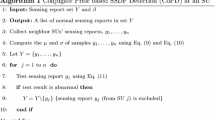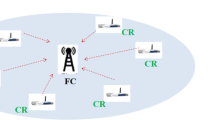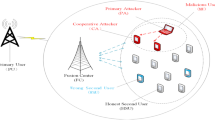Abstract
Despite the cognitive radio network is the emerging technology for avoiding the underutilization of spectrum by allowing secondary users (SU) to share with the licensed band of the primary user (PU), it has its disadvantages such as QoS degradation, connection unavailability, Denial of service and bandwidth waste due to false signal injecting by the secondary users. Moreover, howbeit existing techniques have mitigated the underutilization of spectrum band, it has brought degradation to primary users due to lack of cooperative optimal sensing. To solve these problems, this work proposed a Reservation Optimized Bias Decomposition system (ROBD) to sense the available spectrum and reserve the spectrum based on user needs and employ slots to share a shared transmission resource, resulting in greater spectrum usage. By reducing the false signal into a series of smallest feasible sub-problems and solving them analytically, optimized bias decomposition techniques are used to discover and eliminate the internally injected false signal. As a result, issues like QoS deterioration, connection unavailability, denial of service, and bandwidth wastage has been removed. If the crumbled signal has high bias and variance when tested with the trained model it would be filtered this leads to less packet drop and high quality of service. The proposed method has obtained a higher throughput of 4.6052 and a low packet drop of 28.47 bits/sec, such a way the proposed method outperforms the other existing techniques.




















Similar content being viewed by others
References
Akyildiz IF, … Mohanty S (2008) A survey on spectrum management in cognitive radio networks. IEEE Commun Mag 46(4):40–48
Ali A, Hamouda W (2017) Advances on spectrum sensing for cognitive radio networks: theory and applications. IEEE Commun Surv Tutorials 19(2):1277–1304
Ali A, Zhu Y, Chen Q, Yu J, Cai H (2019) Leveraging spatio-temporal patterns for predicting citywide traffic crowd flows using deep hybrid neural networks. In 2019 IEEE 25th international conference on parallel and distributed systems (ICPADS). IEEE:125–132
Ali A, Zhu Y, Zakarya M (2021) A data aggregation based approach to exploit dynamic spatio-temporal correlations for citywide crowd flows prediction in fog computing. Multimed Tools Appl 80(20):31401–31433
Ali A, Zhu Y, Zakarya M (2021) Exploiting dynamic spatio-temporal correlations for citywide traffic flow prediction using attention based neural networks. Inf Sci 577:852–870
Ali A, Zhu Y, Zakarya M (2022) Exploiting dynamic spatio-temporal graph convolutional neural networks for citywide traffic flows prediction. Neural Netw 145:233–247
Anandakumar H, Umamaheswari K (2017) Supervised machine learning techniques in cognitive radio networks during cooperative spectrum handovers. Clust Comput 20(2):1505–1515
Anandakumar H, Umamaheswari K (2017) An efficient optimized handover in cognitive radio networks using cooperative spectrum sensing. Intelligent Automation & Soft Computing 1-8.
Arjoune Y, Kaabouch N (2019) A comprehensive survey on spectrum sensing in cognitive radio networks: recent advances, new challenges, and future research directions. Sensors 19(1):126
Awe OP, Deligiannis A, Lambotharan S (2018) Spatio-temporal spectrum sensing in cognitive radio networks using Beamformer-aided SVM algorithms. IEEE Access 6:25377–25388
Chen K, Chen F, Lai B, Jin Z, Liu Y, Li K, Wei L, Wang P, Tang Y, Huang J, Hua XS (2020) Dynamic spatio-temporal graph-based CNNs for traffic flow prediction. IEEE Access 8:185136–185145
Dannana S, Chapa BP, Rao GS (2018) Spectrum sensing using matched filter detection. In Intelligent Engineering Informatics. Springer, Singapore 497-503.
Eappen G, Shankar T (2020) Hybrid PSO-GSA for energy efficient spectrum sensing in cognitive radio network. Physical Commun 40:101091
Elnahas O, … Furukawa H (2018) Game theoretic approaches for cooperative Spectrum sensing in energy-harvesting cognitive radio networks. IEEE Access 6:11086–11100
Ghasemi A, Elvino Sousa S (2008) Spectrum sensing in cognitive radio networks: requirements, challenges and design trade-offs. IEEE Commun Mag 46(4):32–39
Kar S, Sethi S, Sahoo RK (2017) A multi-factor trust management scheme for secure spectrum sensing in cognitive radio networks. Wirel Pers Commun 97(2):2523–2540
Karimi M, Sadough SMS, Torabi M (2020) Enhanced physical layer security for cognitive radio systems through joint spectrum access and power allocation. IET Commun 14(18):3135–3142
Li Z, Yu FR, Huang M (2009) A distributed consensus-based cooperative spectrum-sensing scheme in cognitive radios. IEEE Trans Veh Technol 59(1):383–393
Liang Y-C et al (2008) Sensing-throughput tradeoff for cognitive radio networks. IEEE Trans Wirel Commun 7(4):1326–1337
Ma J, Zhao G, Li Y (2008) Soft combination and detection for cooperative spectrum sensing in cognitive radio networks. IEEE Trans Wirel Commun 7(11):4502–4507
Mapunya S, Velempini M (2018) Investigating spectrum sensing security threats in cognitive radio networks. In: Ad hoc networks. Springer, Cham, pp 60–68
Mummoorthy A, Suresh Kumar S (2012) A detailed study on evolution of recent jammers in wireless sensor networks. Int J Eng Res Dev 4(6)
Niyato D, Hossain E (2008) Competitive spectrum sharing in cognitive radio networks: a dynamic game approach. IEEE Trans Wirel Commun 7(7)
Pandit S, Singh G (2017) In overview of spectrum sharing techniques in cognitive radio communication system. Wirel Netw 23(2):497–518
Sultana A, Fernando X, Zhao L An overview of medium access control strategies for opportunistic spectrum access in cognitive radio networks. Peer-to-Peer Networking Appl 10(5):1113–1141
Tavares CHA, Abrão T (2017) Bayesian estimators for cooperative spectrum sensing in cognitive radio networks. URUCON, IEEE.
Thakur S, Singh A (2020) Secure transmission using optimal antenna selection for MIMO underlay CRN with multiple primary users. IET Commun 14(7):1090–1101
Vimal S, Kalaivani L, Kaliappan M (2017) Collaborative approach on mitigating spectrum sensing data hijack attack and dynamic spectrum allocation based on CASG modeling in wireless cognitive radio networks. Cluster Comput. 1-11.
Wang L, Alexander Wyglinski M A Combined Approach for Distinguishing Different Types of Jamming Attacks Against Wireless Networks
Wang M (2020) Performance analysis of opportunistic relay selection cooperative communication in cascaded fading channels. IOP Conf Series: Mat Sci Eng 719(1):012045
Wang Q, Ren K, Ning P (2011) Anti-jamming Communication in Cognitive Radio Networks with Unknown Channel Statistics. 19th IEEE International Conference on Network Protocols.
Wei X, … Fan J (2017) Jammer localization in multi-hop wireless network: a comprehensive survey. IEEE Commun Surv Tutorials 19(2):765–799
Wu Q, Ding G, Wang J, Yao YD (2013) Spatial-temporal opportunity detection for spectrum-heterogeneous cognitive radio networks: two-dimensional sensing. IEEE Trans Wirel Commun 12(2):516–526
Xing Y, Mathur C, Haleem M, Chandramouli R, Subbalakshmi K (2006) Priority based dynamic spectrum access with QoS and interference temperature constraints. In Proc. IEEE ICC 4420_4425.
Xu X, Yang W, Cai Y (2017) Opportunistic relay selection improves reliability–reliability tradeoff and security–reliability tradeoff in random cognitive radio networks. IET Commun 11(3):335–343
Yucek T, Arslan H (2009) A survey of spectrum sensing algorithms for cognitive radio applications. IEEE Commun Surv Tutorials 11(1):116–130
Zeng PECY, Hoang AT (2008) Sensing throughput tradeoff for cognitive radio networks. IEEE Trans Wirel Commun 7(4):13261337
Zhang D, … Shen XS (2017) Energy-harvesting-aided spectrum sensing and data transmission in heterogeneous cognitive radio sensor network. IEEE Trans Veh Technol 66(1):831–843
Zhang W, Ranjan Mallik K, Letaief KB (2009) Optimization of cooperative spectrum sensing with energy detection in cognitive radio networks. IEEE Trans Wirel Commun 8(12)
Zhang W, Ranjan Mallik K, Letaief KB (2009) Optimization of cooperative spectrum sensing with energy detection in cognitive radio networks. IEEE Trans Wirel Commun 8(12)
Zhao W, Li H, Jin M, Liu Y, Yoo SJ (2020) Eigenvalues-based universal spectrum sensing algorithm in cognitive radio networks. IEEE Syst J 15(3):3391–3402
Zheng S, Kam PY, Liang YC, Zeng Y (2013) Spectrum sensing for digital primary signals in cognitive radio: a Bayesian approach for maximizing spectrum utilization. IEEE Trans Wirel Commun 12(4):1774–1782
Data availability statement
None.
Author information
Authors and Affiliations
Corresponding author
Ethics declarations
Conflict of interest
None.
Additional information
Publisher’s note
Springer Nature remains neutral with regard to jurisdictional claims in published maps and institutional affiliations.
Rights and permissions
Springer Nature or its licensor holds exclusive rights to this article under a publishing agreement with the author(s) or other rightsholder(s); author self-archiving of the accepted manuscript version of this article is solely governed by the terms of such publishing agreement and applicable law.
About this article
Cite this article
Nagalakshmi, P. An ingenious ROBD system to slay invasion attack for profitable spectrum utilization. Multimed Tools Appl 82, 7079–7104 (2023). https://doi.org/10.1007/s11042-022-13631-3
Received:
Revised:
Accepted:
Published:
Issue Date:
DOI: https://doi.org/10.1007/s11042-022-13631-3




